Part 1: Overview

Map of Japan
This section is an overview of Japanese history, from the earliest times to the present. Unlike China and Korea, the borders of Japan have stayed relatively stable throughout most of its history due to its geographic status as a group of islands. Until the mid-20th century, historic Japan was never occupied by another people and in turn never held territorial possessions on the mainland or major islands nearby until the late 19th century – though attempts were made at colonizing the Korean peninsula in the late 16th century. From the late 19th century until 1945, the imperial Japanese government had colonies in Taiwan, Korea, Northeast China and, during WWII, major parts of Southeast Asia. Since 1945, Japan has remained in its traditional territory, though a few islands are still held in dispute with various states in the region.
The Japanese people of today seem to have had ancestors that came from several places. Although in antiquity the mountainous islands were once connected to the mainland, after the last Ice Age, the waters rose, isolating the island group. Whatever the origins of the earliest inhabitants were, some groups may have come from nearby Siberia, the Korean peninsula, the Yellow River and Yangzi River areas of present-day China and the southern chain of islands that lead down into Polynesia. By at least 300 BC, significant populations with advanced metal technology, rice agriculture, and horses began arriving from the Korean peninsula, and the dates of such migrations may yet be pushed back farther.
As culture developed in Japan, there were several periods when archaeological and historical evidence point to the rapid introduction of cultural elements from other places. These cultural borrowings were subsequently “re-made” in Japan to fit local needs and tastes. In some periods, cultural borrowing proceeded in a systematic matter, with definite goals in mind. This process of controlled selection and adaptation was enhanced by the island nature of the country. The Age of Reform (552-710 AD), the Meiji Period (1868-1912), and the decades right after WWII are three prominent examples. In studying modern Japanese culture, it is still possible to see “layers” of these influences from the past. At various times in history, the major sources of these influences have been states on the Korean peninsula, Silk Road cultures, China, Europe, and the United States. After periods of intense borrowing, Japan has often withdrawn into itself and the foreign cultural influences have become Japanese, sometimes taking new and creative directions. A good example would be certain styles of Japanese art and architecture that were once based on Chinese models.
It is interesting to note that in some instances the successes at borrowing and remaking were wildly successful—the modern auto industry, for example. Other experiments in cultural borrowings sometimes took unexpected directions. A good example is the attempt to introduce the Chinese-style of imperial government starting in the 7th century AD. Although certain codes and reforms were established for several centuries, the grand experiment of a Confucian style bureaucracy began to deteriorate by the 10th century. This was due to monopolization of court politics by the powerful Fujiwara family. This style of government was then largely abandoned by the late 12th century, when a form of Japanese feudalism arose. In this new system, the emperor became a divine figurehead, while real power lay in the hands of the paramount military leader known as the shogun. This era gave way to a culture of warrior-aesthetes, quite distinct from the clearer separation between civil and military cultures in the Chinese state.
Today, Japan is a super-modern and developed country that is still able to hold onto selected vestiges of its rich cultural heritage. Tokyo and Osaka are highly cosmopolitan cities that feature cultural elements from all over the globe. Yet, a “Japanese” aesthetic prevails as past and present cultural influences continue to interweave in one of the most powerful engines of popular culture on earth.
Part 2: Prehistory
Jomon c. 8,000-300 BC
The evidence of chipped stone tools suggests that humans inhabited Japan at least 30,000 years ago. "Neolithic" cultures called “Jomon” still retained stone tool and pottery traits of earlier periods that date to at least 10,000 BC. The Jomon people were hunters and gatherers who lived upon the rich resources of game, fish, and wild plants native to post-Ice Age Japan. “Jomon” means “cord-marked pottery,” one of the defining examples of material culture that survive from this people. Jomon pottery is also some of the oldest reliably dated on earth. By 8,000 BC this type of cord-wrapped pottery - with decorated lines made by wrapping or laying cords on wet clay – was developed. Other clay objects are the so-called “dogu” figurines. These are small human-like figurines that may have been used in fertility worship. Another theory is that they were used as talisman in shamanistic practice to ward off illness. Always few in number, the Jomon peoples were first concentrated on the southern island of Kyushu before moving to the Kansai and Kanto plain areas of the main island of Honshu.
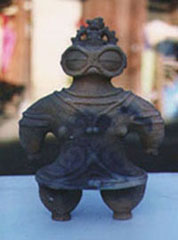
A dogu figurine
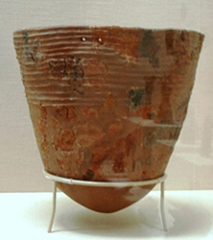
Jomon pottery with rope design
Yaoyoi Period c. BC 300- AD 300
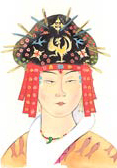
Queen Pimiko
Japan first appears in the historical records of China in about 300 BC. In those records the inhabitants of Japan were known as the “Wa.” The records tell of a Queen named Pimiko (Himiko) who had a tribal domain in the southwest areas of Honshu and Kyushu. According to the accounts she lived in a hill-top fortress and was waited upon by 1,000 young women. Her brother handled communications outside the walls, acting as a sort of regent. The queen may have had a dual role as a type of shaman with links to the spirit world. It is not known if she was related to the gods. Eventually, Japanese emperors would trace descent directly to the Sun Goddess, Amaterasu, who along with her brother Susanoo, were instrumental in the creation story of Japan.
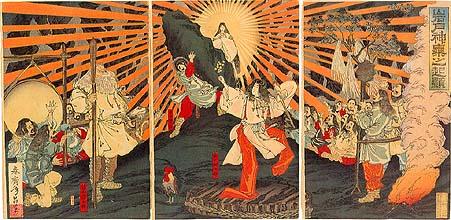
The Sun Goddess Amaterasu emerges from her cave to watch the other gods dance
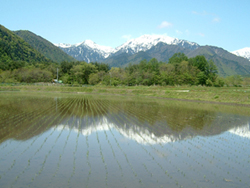
Wet rice field
During the Yayoi period a number of new technological and agricultural elements arrived from the Asian mainland, most probably by boat from the Korean peninsula. Among the new cultural attributes were wet-rice agriculture, bronze and iron, new styles of pottery, livestock, and a whole host of cultural patterns having to do with village and elite life. Most likely, these elements of culture were carried to Japan by waves of immigrants who settled around the land, gradually displacing or absorbing the native populations. It is unclear how the aboriginal Ainu fit into the picture of these early periods of Japan, but warfare with displaced tribes continued for centuries.
Part 3: Early Kingdoms and Classical Age
Tomb Period c. AD 300-552
By the Tomb Period population centers had grown up in several parts of the islands and the roots of city culture had taken place. Contact with cultures in China and especially the Korean peninsula continued. With the exception of the northern wilderness of Hokkaido and parts of southern Kyushu, clans known as “uji” controlled many portions of the islands.
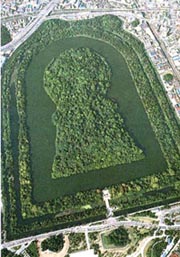
Key-hole shaped kofun
Chinese records from the latter part of the era tell of a powerful uji family known as the Yamato, located in the plain between the present cities of Nara and Osaka. By this time a stratified society had developed consisting of rulers, craftsmen, farmers, and even some slaves. The Yamato were only one of many tribal units, which according to Chinese records, fought incessantly among each other. The Yamato had relations with China, as well as several states on the Korean peninsula. The present emperor of Japan traces his descent to the Yamato ruling family.
The Yamato Plain region is the site of the oldest tomb mounds in Japan. These tomb mounds (kofun) are in some ways similar to earlier ones found in China and those on the Korean peninsula from around the same time frame. A number of huge mounds are in the shape of an old-fashioned key-hole, though many smaller ones were hemispherical in shape.
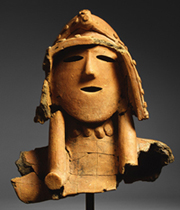
Haniwa sculpture: bust of a warrior
A style of clay sculpture known as haniwa is associated with some of the grave mounds. The haniwa are earthenware pottery made of hollow tubes of clay. The subjects are abstracted humans of various occupations, farm animals, houses, boats, and other items. In ways they are similar in spirit to the clay items placed in graves in Han dynasty China. In some cases the inside of the larger tombs were decorated with murals, as seen in early China and Korea. By the fifth century, models of horses and bronze horse tack appear, along with more sophisticated metal swords, bows and arrow, and spears.
Age of Reform AD 552-710
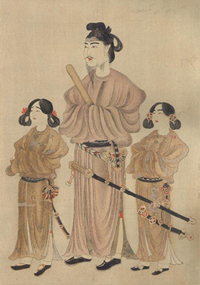
Prince Shotoku
Influences from China and other mainland civilizations on the Silk Road made their way into Japan via people moving to and from on the waters of the Tsushima Straits between Japan and Korea and the greater Yellow Sea interaction sphere. By 607 AD a ruler in Japan by the name of Prince Shotoku (574-622) sent a mission of monks, government representatives, and students on a prolonged “study abroad program” to China in order to increase the rate of importation of the positive aspects of Chinese culture. Among the imports were literacy in Chinese (Shotoku had a Korean scribe to help with this task), Buddhism, art, customs, and principles of Chinese rule. The gifted prince, regent for his mother, the Empress Suiko, commissioned a temple complex at present day Horyuji. He also drafted Japan’s first written government constitution, the 17–Article Constitution.
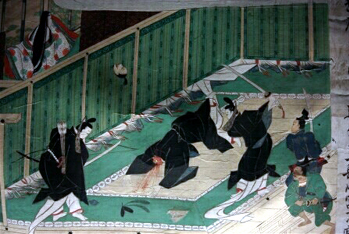
A painting depicting the Taika Reform era
As time went on, over six missions were sent to China, and reforms were instituted in Japan, first in the Yamato court, then elsewhere. In 645 AD, a reformer named Fujiwara no Kamatari (614-669) extended the implementation of the Chinese model of government by canonizing a set of legal reforms known as the Taika Reforms. Later, the Emperor Temmu (reigned 672-686) introduced more institutional and legal reforms on the model of Tang dynasty, China. In a break with the past (and in imitation of the Chinese “son of heaven”), he took the title of “heavenly emperor” (tenno), rather than king. In 702 AD, another set of legal guidelines called the Taiho Code were drawn up in an attempt to resolve contradictions between government interests in taxation and the landholdings of large uji, who were in constant factional struggles over power with the centralized government. Eventually monasteries and large estates gained a special tax-exempt status, and the peasants shouldered the burden of taxation.
During the Age of Reform, the Japanese set in place the foundations for an experiment in Chinese-style rule that would bear fruit in an elite culture unrivaled in Japanese history, lasting until the late 12th century. The next two eras, the Nara and Heian, are known as the “classical age” of Japan.
Nara Period AD 710-794
Nara is regarded as the first permanent capital in Japan. Before that time the capital was relocated at the demise of each ruler due to taboos involving pollution of the living site by death. Following the Chinese model of a permanent seat of government, the new capital was modeled on the capital of Tang China, Chang’an (today's Xi'an city).
The earliest part of the city (which was on a much smaller scale than Chang’an and without a wall) was based on a rectangle of eight squares, built on a north to south axis with streets running through them in a neat grid pattern. The city was divided into two halves: the Left Capital and the Right Capital. The new palace was placed to the north. A major causeway, called the Scarlet Phoenix Avenue, ran down the middle of the city, leading to the palace.
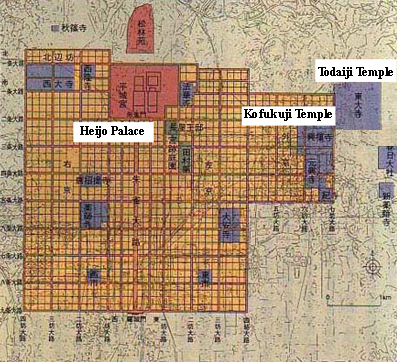
Nara was layed out in a grid pattern like ancient Chinese cities. The map notes several important sites.
After its establishment in 710 AD, Nara would become a city renowned even today for its architecture and tradition of Buddhist art. Although the structures remaining in Nara today were built in later centuries, many were constructed on sites dating to the earliest years of the kingdom. Some of the best descriptions of these early sites come from a huge tourist guidebook compiled by a poet and printed in 1681.
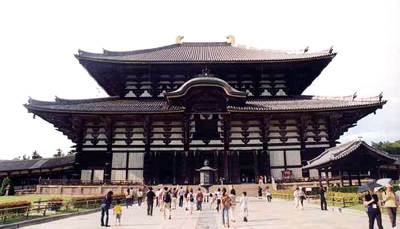
The Todaiji Buddhist temple is the largest wooden structure on earth. It is an important landmark in Nara.
Much of what is known about life in the Nara period centers on the lifestyles of the elite in the capital cities. The use of classical Chinese as a literary language increased throughout the Nara period. While government documents and literature in classical Chinese were produced, this was also the first flowering of native Japanese literature. The most important example of this is the first collection of Japanese poems, known as the Collection of Ten Thousand Leaves, or Manyoshu. Buddhism became an important force in the capital and was patronized by the government. Statues of Buddha were commissioned, 48 temples built within Nara and many more throughout the land, and Buddhist scriptures were mass-produced and spread everywhere. A scandal late in the period involved a powerful Buddhist monk who manipulated the ruling empress and nearly took control of the throne. Although a number of women had ruled in Japan (usually after the death of their husbands), this custom was brought to an end because of the scandal.
Although the capital city and other upper-class echelons were developed under the influence of imported Chinese culture, the rural villages and farmsteads were much more conservative. Farmers in some areas lived in pit houses partially underground and farmed wet-rice. Dry land fields were still cleared by agricultural techniques that involved burning off brushy and forested areas and planting in the ash-rich soil.
The Nara period was characterized by continued importation of Chinese culture and the spread of Buddhism. In the next period, the Heian period, the Chinese influences would be “re-made” with Japanese characteristics, in some cases preserving aspects of Chinese culture that were long out of fashion in China. However this was also the time when the cultural modes were developed that would influence Japan for the next thousand years. Let's take a look at a famous street in Nara today.
Heian Period AD 794-1185
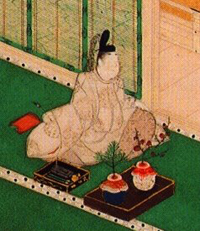
"Shining" Genji
In 794 AD a new capital was founded at Heian, the site of the present city of Kyoto. The Heian period would prove to be the height of classical culture in ancient Japan. The samurai of later ages would look back to Heian as a source of patterns of elite culture, which they wove into their more militaristic outlook. Again taking the Tang dynasty capital as a model, the new city was a third the size of Chang’an (Xi’an) and had a low wall. Heian is the age of the “Shining Lord”—the age of Hikaru Genji, the major character in the Murasaki Shibuku’s Tale of Genji. Based on accounts of Japanese and Western visitors, Ivan Morris gives a description of the setting of the capital in the pre-industrialized era:
The capital itself was situated in beautiful country, encircled on three sides by thickly forested hills and mountains, often delicately wreathed with trails of mist; in the autumn evenings one could hear the deer’s cry in the distance and the desolate call of the wild geese overhead; the landscape abounded in streams and waterfalls and lakes; and into its green slopes and valleys the countless shrines and monasteries blended as if they too had become a part of nature. (Morris, p. 34)
Life at the courts became insulated from the rest of the world and the relative peace of most of the era allowed for a flowering of culture. New forms of writing called kana were created that easily reflected the sounds of the Japanese language. Although much easier than learning classical Chinese, scholars and bureaucrats preferred Chinese and its elite associations, while the new written language was soon used by court women as a new medium for writing prose.
Court women such as Sei Shonagon and Murasaki Shikibu contributed to the creation of a “women’s” literature that rivaled any prose writings in the world of that time—though of course it was entirely unknown outside of a tiny audience in Japan. One of the aesthetic principles reflected in the literature of the period was that of miyabi, or “courtly elegance.” The term appears hundreds of times in the Tale of Genji and refers to the gentle, often ritualized, and sensitive manners cultivated by the elite of the time. Another important aesthetic element, that evolved further with introduction of Zen Buddhism in later centuries, is the concept of mono no aware, or “sensitivity to things.” Enhanced by the natural beauty of Japan, the aesthetic was based on the idea that the heart/soul is stimulated by images of the sublime in nature. Thus, a falling cherry blossom or an autumn leaf circling in a pool creates subtle and indescribable feelings that can only be expressed by poetry or other arts. The Tale of Genji is a long, complicated narrative covering several generations. Often called “the world’s first novel,” Murasaki Shikibu’s work continues to influence Japanese culture to this day. Sei Shonagon’s collection of essays, The Pillow Book (Makura no Soshi in Japanese) was another important work. It details the personal and political lives of the most powerful Court figures of the day. The “Collection of Japanese Poems New and Old” (Kokinwakashu) was the most important collection of poetry in the Heian era. It would also influence and inspire Japanese culture for the next thousand years.
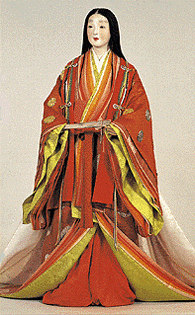
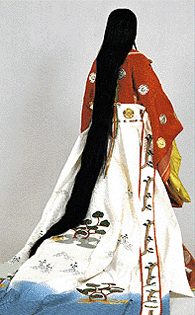
Front and back images of a high-ranking noblewoman in Heian
Courtly refinement and aesthetic sensitivity were reflected in the daily dress and manners of the elite. Both men and women’s clothing and adornment were subject to conventions of the day. Women wore an elaborate costume of up to twelve inner and outer layers of cloth. Natural white teeth were colored black with a solution of iron and powdered gallnut soaked in vinegar (temporary teeth blackening remains as a part of the process of becoming a geisha entertainer in Kyoto today). Hair was decorated with ornaments at the start of the Heian period, but this eventually went out of fashion. Aristocratic women wore their hair as long as possible – even to the ground. White powder was applied to the face and neck and light rouge on the cheeks. Eyebrows were plucked and misty dark blotches were painted high upon the forehead. Lips were painted red like tiny flower buds. Like the standards for Tang dynasty women, Heian women cultivated full figures, although bodies were not displayed in public, hidden beneath the mounds of cloth. Aristocratic women were also hidden behind an elaborate system of blinds and screens, described at length in the literature of the time.
Elite women were educated in calligraphy, poetry, music, and customs such as incense preparation, which allowed them some intellectual parity with men of their class with similar training. Although most upper class women spent their days in secluded leisure at home, possibly engaging in embroidery and dyeing cloth, women of the court like Sei Shonagon, had somewhat more public lives. Interactions between the sexes (other than close family members and lovers) were rarely direct. Communication, when necessary, was often through carefully crafted letters delivered by go-betweens or servants. Elite men led much more public lives, involved in politics and the running of their estates. Although the power of Buddhism was not allowed to increase to the point it had in Nara, a new form of Buddhism that offered salvation to all believers was imported from China by a monk named Saicho (767-822 AD). The new Tendai (Tiantai) beliefs soon became widespread among the nobles and the populace. Esoteric Buddhism also gained a strong hold in Japanese culture at this time. The Shingon (“True Word”) sect of esoteric Buddhism was founded by the great monk Kukai (774-835.) One of the great geniuses of Japanese history, Kukai studied for many years in China under famous Buddhist scholars. Kukai’s own teachings and doctrines are some of the most complex and profound in all of Buddhism. Many great temples and monasteries of several sects of Buddhism remain in Kyoto today, as living testaments of the great Buddhist tradition in Japan.
During the Heian period, the experiments with centralized Chinese rule and taxation gradually faded into a situation with a weak central government ruled by an emperor who was increasingly a figurehead. This was due to monopolization of the Imperial Court by the Fujiwara family. A large family with roots in the noble uji of the past, the Fujiwara gained control through marriage politics. Fujiwara daughters became the mothers of emperors. Their maternal grandfather would then act as regent, effectively controlling the central government. The most powerful of these men was Fujiwara no Michinaga (996-1027.) Michinaga became the de facto power over all of Japan and the most powerful non-military ruler in Japanese history. However toward the end of the 12th century the power of the Fujiwara was in decline. Large warrior clan families like the Minamoto, and Taira increased their power and holdings and came into conflict with each other and other families over control of the realm.
Part 4: Feudal Era in Japan
Kamakura Period AD 1185-1333
The turmoil of the Kamakura period contrasts sharply with the refined atmosphere associated with the classic age of Heian culture. During this period, attempts were made at ruling Japan through a centralized Imperial Chinese model, backed by civil codes, that evolved into a system similar in spirit and substance to feudalism in Europe. In this epoch, the warrior class of samurai takes the stage, and militancy becomes the social and political norm. The role of the emperor becomes almost wholly ceremonial, as the military side of the government, under the leadership of the shogun (generalissimo of the Imperial Army), took actual control of policy and implementation. By the end of the era, Japan would become an island nation filled with warring armies associated with rival family domains struggling for political and military dominance.
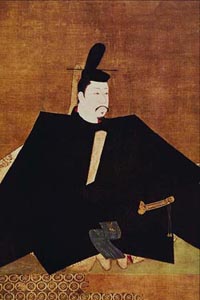
Minamoto Yoritomo
With the power of the Fujiwara in decline, the powerful warrior families of the Minamoto and the Taira fought for control of Japan in the Gempei War of the late 12th century. A new era began with the rise of the first shogun. The winner in the prolonged struggle of the Gempei War, a general named Minamoto Yoritomo (1147-1199AD) set up a new government in the Kanto plain, quite close to the present city of Tokyo. At this moment, real power shifted from the western Kansai region around Heian-kyo (Kyoto) to Yoritomo’s military government at Kamakura. The new government was called bakufu or “tent government,” suggesting a military encampment. Although the emperor continued to exist in Kyoto, and was acknowledged by Yoritomo and succeeding shoguns, from this point on (with one brief exception), the role of the emperor would be minimal until the Meiji Restoration in 1867. Yoritomo simplified the government processes and instituted a basic legal code, although the court in Kyoto retained much of its form and administrative function. Large family domains retained varying numbers of samurai – professional military men something like the knights of Europe. Common people tilled the land, much as they had always done. While control of the bakufu shifted to the Hojo family after Yoritomo’s death, the system of government that he established was to be the basic model for control of Japan until the modern era.
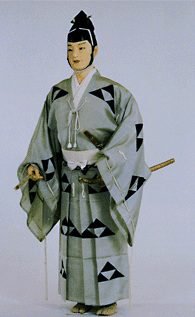
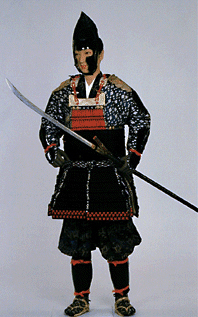
Samurai in daily wear and armour
The greatest threat to Japanese sovereignty before the great changes of the 19th and 20th centuries came during the Kamakura period with the attempts by the Mongols of Kublai Khan to invade Japan. Two major attempts, seven years apart in the late 13th century were launched from the Korean peninsula. The Mongols commandeered thousands of ships, boats and crews from Korea and China in the invasions. The samurai warriors who still used one-on-one battle tactics based on horseback archery, then swords (once on the ground), put up a stiff resistance against the Mongol forces, but ultimately would have been little match for the coordinated military tactics of massed archers, fire bombs, and siege weapons in the Mongol military arsenal. The Mongols, however, seem to have been no match for the protective kami (local gods) of Japan, who sent ravaging typhoons (the “divine winds” or kamikaze) that twice sunk the Mongol fleets before full-scale invasions could take place. The lingering fear of Mongol attacks only strengthened military culture in Japan, which continued to develop in the ensuing centuries of unrest. While Japan was saved from invasion by the Mongols, the unrest caused by the threat of Mongol invasion weakened the bakufu in Kamakura.

Second Mongol invasion of Japan in 1281
Kemmu Restoration AD 1333-1336
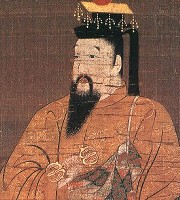
Emperor Go-Daigo
A very short period in Japanese history marked the transition between the Kamakura and Muromachi Periods. This era is known as the Kemmu Restoration and is the last time a Japanese emperor attempted by force to take control of Japan. This occurred in 1333, when Emperor Go-Daigo attempted to re-institute direct imperial rule by amassing forces against the bakufu government of the prevailing shogun. Emperor Go-Daigo sent his troops under the leadership of General Ashikaga Takauji to route the resisting factions. In the course of events Go-Daigo gave support to some of Ashikaga’s rivals, which in turn stimulated Ashikaga to turn the tables. Returning to Kyoto, he drove Go-Daigo into the hills, and managed to place a new emperor (from another imperial line) on the throne. Nevertheless, Go-Daigo set up a government in exile in Yoshino, a site in present-day Nara. The division of the Imperial Court in Japan lasted for several decades. This event ushered in an era of almost constant martial strife between the regional domains in Japan, as local lords contested for the position of shogun and the hierarchical feudal system further developed.
Ashikaga Period AD 1336-1573
Although fate intervened to save Japan from the Mongols, the Mongol invasions brought instability to the emerging Japanese feudal system, which eventually descended into a state of turmoil and incessant fighting between local warlords. No one leader managed to gain firm control over the entire realm at this time. Though Kyoto continued as a grand capital, the base of military power was scattered throughout the land.
During this period, feudalism developed further. The emperor (dwelling in Kyoto) was the divine leader of the land, though functioned more as a figurehead who gave legitimacy to the rule of the shogun. The Ashikaga shoguns controlled the area around the city of Kyoto, however the rule did not extend throughout Japan. At this time several regional lords, calling themselves “daimyo” (meaning “great name”) held large tracts of land. Daimyo were always fighting with each other and the Ashikaga government for control of territory. These regional lords all employed armies of samurai, and below them were the townspeople and peasant farmers. The samurai code of service demanded loyalty to lord and one’s family name as well as self-discipline and perfection in the martial arts. Dishonor was the occasion for ritual suicide by sword.
During this period a new literature emerged, often on martial themes. The aesthetic of such works is that of sabi, which reflected a deep melancholy or sadness over the brevity of existence. A related concept is that of wabi, the effect of construed naturalness exhibited in an artwork such as the cracks or irregularities in the glaze on a tea bowl that reflect the effects of primitive firing techniques. These aesthetics are also part of the appreciation of Japanese garden architecture. They were developed in the growing culture of Zen Buddhism that was favored by the warrior class. Cultivation of these aesthetics, linked with Zen meditation, became an important dimension of the warrior samurai culture in later eras of Japanese history. “The Tale of Heike” (Heike Monogatari) although existing in other oral forms before this time, is the best-known of these martial works and epitomizes this era. A samurai might contemplate the beauty of a meadow flower in one instant, and engage in mortal combat in another (as exemplified in a famous scene in the Akira Kurosawa film, Seven Samurai).
Noh theater was also developed at this time. Originally called sarugaku (“monkey music”), noh is a form of minimal masked drama placing great importance on dance and chant. The actor-playwright Kannami (1333-1384), followed by his son Zeami (1363-1443) were the two most important figures in the rise of noh. Zeami especially is credited with innovation of the tradition into a highly complex form of drama. Zeami’s aesthetics of noh are now seen as the artistic standards of this era.
More popular forms of Buddhism like the Pure Land (Jodo) and Nichiren sects were spread throughout the populace. Zen Buddhism, which arrived from the mainland in 1191 via a monk named Eisai (who also introduced the tea ritual), became of great interest to the samurai warrior class in part because of its stress on the exacting discipline of the meditation process.
The time of the Onin Wars (1467-77 AD) was the most bloody and chaotic moment of the period, and destruction was widespread. Kyoto was largely destroyed in the feuds between two great families that spilled into other parts of the realm. The devastating war signaled the beginning of over a hundred years of chaos and strife. Due to a breakdown in what central control there was, social mobility increased between classes and regional overlords competed for soldiers and labor to further their interests. Armies of foot soldiers amassed from the peasantry were now used in warfare. At first armed with spears and pikes, by the end of the era, massed contingents of foot soldiers with firearms were used decisively in battle.
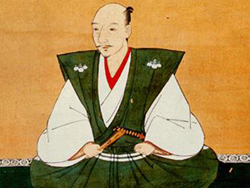
Oda Nobunaga
The latter period of the era (1568-1600 AD) is known as the Age of Reunification. During this period the number of local lords lessened, though those remaining in the struggles grew in power. These “super-lords” were known as daimyo. The three great daimyo in the final decades were Oda Nobunaga (1534-82 AD), the commoner Hideyoshi (1536-98 AD), and a somewhat younger leader in Oda Nobunaga’s retinue named Tokugawa Ieyasu (1543-1616 AD). All three men attempted to unify Japan by creating (or forcing) alliances among the powerful daimyo of the land.
Oda Nobunaga was known as a fierce and relentless warrior whose armies were equipped with matchlock firearms introduced by shipwrecked Portugeuse sailors around 1543. Oda managed to extend his rule over a number of the contending daimyo until his assassination at the hands of a rival whom he light-heartedly struck on the head with a fan at a banquet.
Known as the namban (“southern barbarians”), the Portuguese were later followed by the Spanish. The newcomers had similar goals: trade and conversion of souls to Christianity—an attitude different from the Dutch and British who wanted only trade and plunder. Jesuit priests from Portugal and Spain soon brought Christianity to Japan where it had a mixed reception. Although at one point a following of an estimated two million was gained, unlike Buddhism, the new faith demanded the forsaking of all other beliefs and required allegiance to a foreign and far-away leader in the Vatican. Some Japanese leaders like Oda Nobunaga attempted to use Christianity as a political force (in his case, against the rich Buddhist factions), while others like Tokugawa Ieyasu saw it as a destabilizing force. The new religion was virtually eliminated from Japan in a series of intense purges around 1630 when thousands of leaders and followers were literally crucified. Some aspects of the contradictions between these competing foreign and native forces were included in the plot of James Clavell's novel Shogun, and the film of the same name.
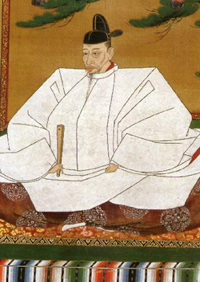
Hideyoshi
Hideyoshi was a former peasant and vassal of Oda Nobunaga who managed to consolidate an even greater number of daimyo than his former lord. As part of his bid for control of Japan, he decreed that townspeople were to remain in towns and peasants were to remain in rural areas, thus lessening mobility between classes. Class divisions were starkly re-emphasized by a great “sword hunt” in which arms were collected from the common people and melted into Buddhist statues. The superior status of the samurai warriors (even lower-level ones) was demonstrated by allowing them to continue wearing two swords in public (one long and one short).
In an attempt to display his power, in the late 1500s Hideyoshi twice sent forces up the Korean peninsula in attempts to conquer the declining Ming dynasty in China that had been constantly pestered by attacks from Japanese pirates. The Japanese fleet was devastated by the armored turtle boats of Korean General Yi Soon-sin and huge numbers of Chinese soldiers who were sent across the northern borders of Choson Korea during the second attack. The mad plans to invade China ended (for the time being) with Hideyoshi’s sudden death in 1598. As the 16th century came to a close, a great battle between contending daimyo took place at Sekigahara in 1600 on the southwest coast. The forces of the patient and methodological Tokugawa Ieyasu won the day, and he soon unified the regional lords and their realms under a new form of advanced centralized feudal government.
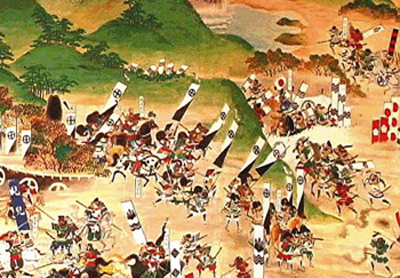
Battle of Sekigahara
Part 5: Tokugawa (Edo) Period AD 1600-1867
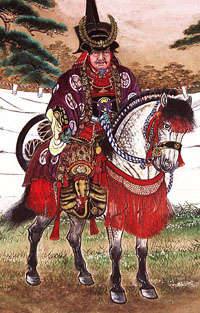
Tokugawa leyasu
Within a decade after the battle of Sekigahara, Tokugawa Ieyasu had established complete control over Japan. He established his shogunate in Edo, now modern Tokyo, though the emperor continued to reside in Kyoto. The innovations that the new shogun put in place would eventually create the conditions for Japan’s swift entrance into the modern world in the mid-19th century.
In order to retain control over the realm, Tokugawa Ieyasu created a centralized bureaucracy, utilizing the new doctrine of Neo-Confucianism that was spreading throughout the mainland, including ministries to oversee the administration of the state. He also instituted a number of policies to control the daimyo, who had been given lands close to the capital (the inner daimyo) or on the fringes (the outer daimyo) in accord to their allegiance (or lack of) during the wars of unification. These policies included regular service to the realm, required upkeep of local castles and other assets, and visits to the capital every other year. This policy was enforced by requiring the local daimyo to lodge their immediate families in Edo. Thus there was a constant coming and going of great processions from the realms of the daimyo along the roadways linking parts of the islands. All this travel was good for the economy, however, and service and supply industries arose along the routes to the capital to feed, lodge, and provide necessities such as footwear, to the retinues.
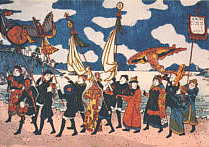
The Dutch traders from Nagasaki to on their way to Edo
Another policy of control had to due with foreign relations. After the expulsion of foreigners (primarily Portuguese and Spanish) and the anti-Christian campaigns, the government followed a policy of seclusion. The fleets were allowed to fall into disuse (which coincidentally ended the problem of piracy that had plagued China and Korea) and trade was severely limited. No citizen, under threat of death, was allowed to freely leave Japan. The Dutch were eventually granted trading privileges at Dejima Island near Nagasaki and the knowledge of European advances in science, medicine, and technology brought by them was known as “Dutch learning.” Some trade was still carried on with the Chinese. Although not completely sealed off, for 250 years Japan remained for the most part in peaceful cloister from the rest of the world.
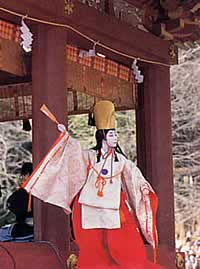
Kabuki drama performance
During the long period of peace in the Tokugawa period the position of the samurai gradually changed. Many filled the layers of central and local government. With no wars to fight, martial training became more ritualized and inter-mixed with revived aesthetics of the Heian period and Zen Buddhism. This is reflected in the samurai tastes for the austere Noh drama, the spartan tea ritual, flower arranging (ikebana), refined incense identification games (something like modern wine tasting), and haiku poetry. Economically, the samurai class (whose members were paid by the great landholders or government in rice) was in decline by the early 19th century.
The merchant class, which had been slowly rising since the end of the Ashikaga period, became economically dominant as a middle-classe composed of traders, shopkeepers, money-lenders, and transport agents, and arose in cities like Edo and Osaka. Enterprises combining production and distribution run by wealthy merchant families like Mitsui and Mitsubishi were precursors of modern multi-national companies. A strong money economy, (rooted in the Ashikaga period when coinage was actually imported from China), was supported by banking and lending institutions. Huge entertainment districts featured boisterous kabuki theater, lively bunraku puppet shows (with wooden puppets 2/3 life-size), and comic storytellers, as well as drinking and delights of the flesh. The milieu of this “floating world” of entertainment was reflected in thematic painting and woodblock prints of the age.
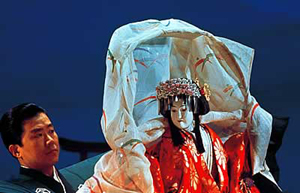
Bunraku puppet show
Education was also of great importance and the literacy rate in urban Japan was high due in part to government sponsorship of schools and widespread printing technology (aided by earlier advances by Korea in the development of moveable metal type). Neo-Confucianism found a following and was promoted by the Tokugawa government that found its secular principles useful in establishing its centralized bureaucracy. Such were the dynamics in a society that would meet its destiny with the industrializing West with the arrival of American gunboats in the mid-19th century.
Part 6: Modern to Present Japan
Meiji Period AD 1868-1912 to Early 21st Century
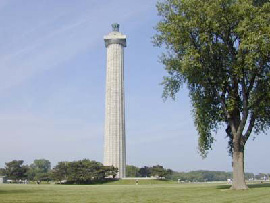
Perry's Monument in Put-in-Bay, Ohio for Commodore Perry's grandfather
In 1853 Commodore Matthew C. Perry (grandson of Admiral Oliver Hazard Perry, the hero of the Battle of Lake Erie in 1812) sailed into Tokyo Bay with a small fleet of “black ships” and demanded that Japan open its ports to trade. Aware of the defeat of China at the hands of the British in the recent Opium War, Japan signed treaties with the United States of America in 1854, and a host of other countries including Great Britain, France, Holland, and Russia soon after. Clauses for “most-favored nation” status were demanded in these treaties, which allowed any privileges extended to any one of the foreign powers to be extended to them all. Townshend Harris (played by John Wayne in the 1960s film “The Barbarian and the Geisha”), the first American diplomat to live on Japanese soil, gradually improved relations between the US and Japan. Nevertheless, as foreign legations were established throughout the land, humiliating incidents occurred, and a movement began to “Revere the Emperor; expel the barbarian!” Eventually an event involving the murder of a British merchant stimulated Britain to fire on a Japanese port. Seeing the power of British guns first-hand, the local daimyo befriended the British captain, and Japan was on its way to imitating the British navy.
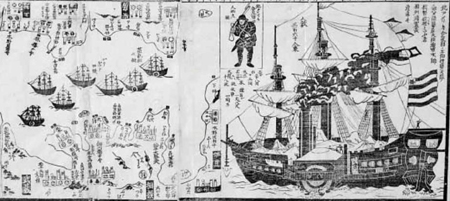
Japanese 1854 print relating Perry's vist
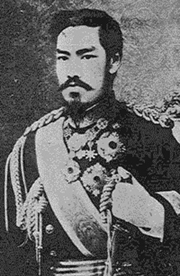
Emperor Meiji
Ultimately, the Tokugawa shogunate was blamed for signing treaties with the foreigners, and a movement among the nobles (many of them the descendants of the “outer” daimyo sent to the fringes by Tokugawa Ieyasu 250 years earlier) eventually swept the last shogun from power. In 1868, a young emperor, aged 16, was set on the throne and with a group of enlightened advisors set out to beat the foreigners at their own game. The new reign was called Meiji. From this time on, Japanese history would be divided into periods in accord with the reign of an individual emperor.
Within a few years, Western-styled navy (copying Britain), army (copying Prussia), industry, banking, legal, and parliamentary systems were eventually introduced. The government also moved to set up railroads, textile mills, and other industries that were in some cases later turned over to the private sector. These changes were largely financed by increasing the tax burden on the peasants and merchants, rather than taking out huge foreign loans. Though Neo-Confucianism was for a time influential in promoting the role of the emperor, Shinto was adopted as a state religion in that the emperor was literally seen as descending from the early kami.
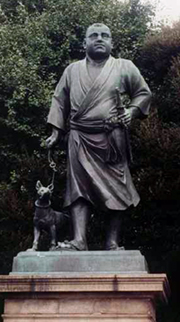
Saigo Takamori statue in Ueno park
In a backlash to these sudden changes, a group of samurai staged the so-called Satsuma Rebellion in 1877. This rebellion was an attempt to save the faltering status of the samurai class, which was being made irrelevant by the new conscript army armed with repeating firearms and modern cannon. The leader, the once-loyal adviser Saigo Takamori, committed suicide on the battlefield in a final fray between modern troops and mounted samurai warriors – an event similar to that in Edward Zwick's 2003 film, “The Last Samurai.”
By 1895 Japan had defeated China in a series of land and sea battles around the Korean peninsula known as the Sino-Japanese War. The victory allowed Japan to gain a foothold in Korea and influence on the nearby Liaodong Peninsula of China. In 1905, the Japanese won a major war against imperial Russia on the Liaodong Peninsula, fought over a new railroad, timber, and seaports in Manchuria—a very strategic corner of East Asia. Casualties were extremely high (over 20,000 in some battles) on both sides due to mechanized firearms and mass, suicidal charges by Japanese troops still motivated by samurai ethics that regarded surrender as dishonorable. Beginning with a surprise attack on the Russian navy, the deciding battle in the Tsushima straits between Korea and Japan resulted in a crippling Russian loss of 33 out of 35 ships sunk—effectively neutering Russian naval influence in East Asia. In many ways this war was a harbinger for Japanese military actions up through the end of World War II and in part explains the calculation to attack Pearl Harbor.
As a result of their 1905 victory and the impending collapse of the Qing dynasty in China, Korea was colonized by the Japanese in 1910. Although a democratic, parliamentary society was being created in Japan in the early decades of the 20th century (universal male suffrage was established in 1925), the Great Depression in the early 1920s helped a radical wing of the Japanese military rise to power. Powerful government-supported companies called zaibatsu aided in creating an effective and modern war machine, unlike anything seen outside of Europe and the United States in World War I.
By the mid-1920s, imperial Japan had extended itself further into Manchuria, and a full-scale invasion in China was underway by the mid-1930s. By the early 1940s the powerful Japanese navy, army, and air forces had enabled Japan to secure most of the former European colonies in East Asia, Southeast Asia, and the Pacific Islands. They were also positioned to threaten Australia. Repeating a miscalculation reminiscent of Hideyoshi’s attempted invasions of China in the 16th century, during late 1941 Japan launched a surprise naval and aerial attack on the United States territory at Pearl Harbor, Hawaii. The attack was triggered in response to US embargos over oil and the materials that fueled Japan’s war machine.
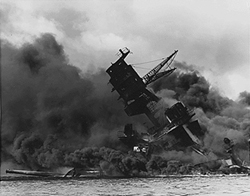
Pearl Harbor attack, December 7, 1945
Though its naval forces were weakened by the Pearl Harbor attack, the US forces fought back with unexpected resolve all across the Pacific islands. Despite fierce and bloody resistance from the Japanese military (employing in the final stages masses of suicide planes known as kamikaze), Japan’s ambitions of empire were ended in August 1945, as the US and the Soviet Union competed to accept the Japanese surrender in northeast East Asia. The final outcome was decided by the controversial use by the United States of the newly created atomic bomb on the cities of Nagasaki and Hiroshima, with massive civilian casualties.

The city of Hiroshima after the U.S. dropped an atomic bomb in August 1945 (U.S. government photo)
Post-War Japan was occupied for seven years (1945-1952) by Allied Forces under the leadership of General Douglas MacArthur of the United States. During this period a new, democratic constitution (ending Japan’s military role the world) was adopted, business re-oriented to peacetime objectives, and the country re-built itself (like other areas in East Asia) after the devastating war. In an interesting twist, the economy was stimulated by the Korean War, when the US forces took out contracts for military goods. Groups of Japanese engineers visited US companies in a systematic effort to modernize production, much as they had learned from China and the West in earlier periods.

Logos of several well-known Japanese companies
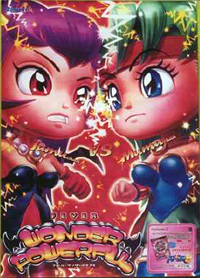
Japan has become a powerful force in global pop culture
Through hard work and determination, Japan re-invented itself in the latter-half of the twentieth century as a consumer-oriented producer. It early-on took the lead in transistor electronics and innovative automobile design (which benefited from traditional Japanese aesthetics), and by the late 1980s was the largest creditor nation on earth, while the US was the largest debtor. With the spread of film, radio, computer games and other electronic devices, Japanese popular culture has a worldwide influence.
Japan’s growth became a model and stimulus for Hong Kong, Taiwan, Singapore, South Korea, Southeast Asia, and eventually the People’s Republic of China (and possibly North Korea, in the future). Although old wounds sometimes still surfaced, a new age of growth and prosperity had arrived in East Asia by the late 1980s.
Though plagued with a stagnant economy since the burst of the “economic bubble” in 1989 and increasingly cognizant of the problems of a “graying society” in which over 21% will soon be over age 65, Japan remains a unique and vibrant culture, now dealing with the dynamic cultures of China and Korea as the history of East Asia continues to unfold.
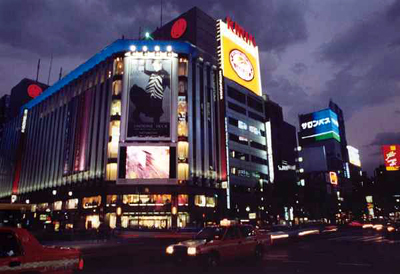
Downtown Tokyo in the evening